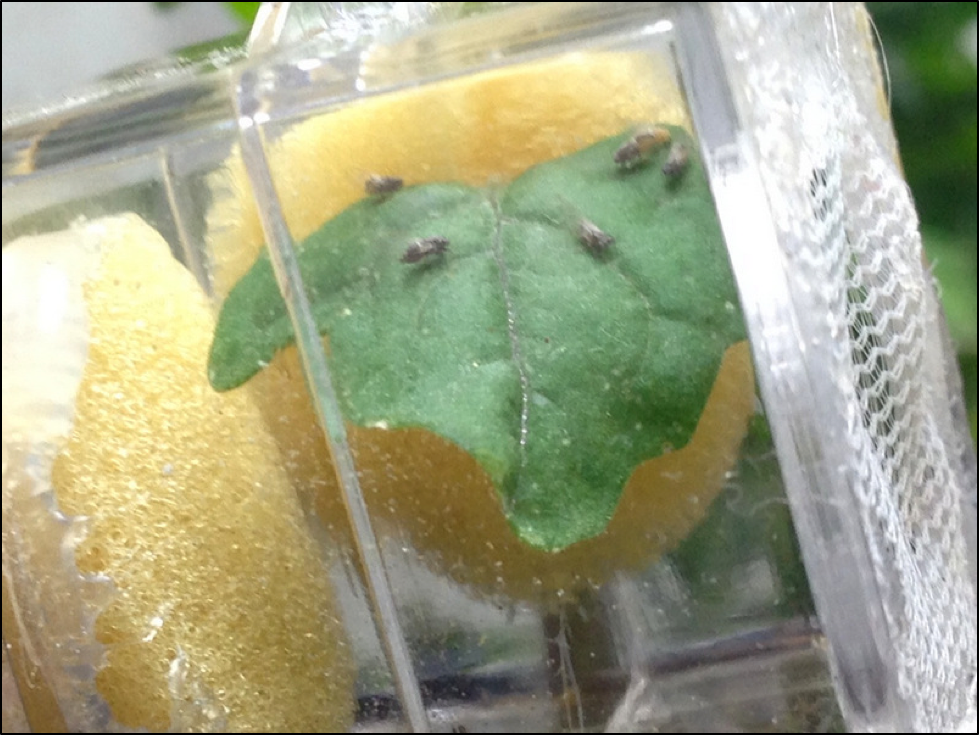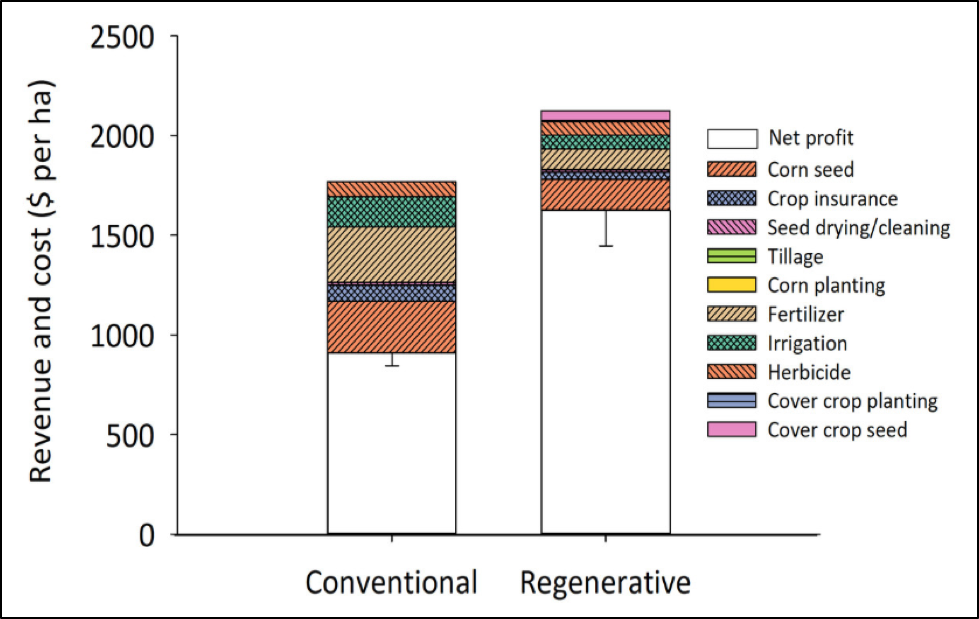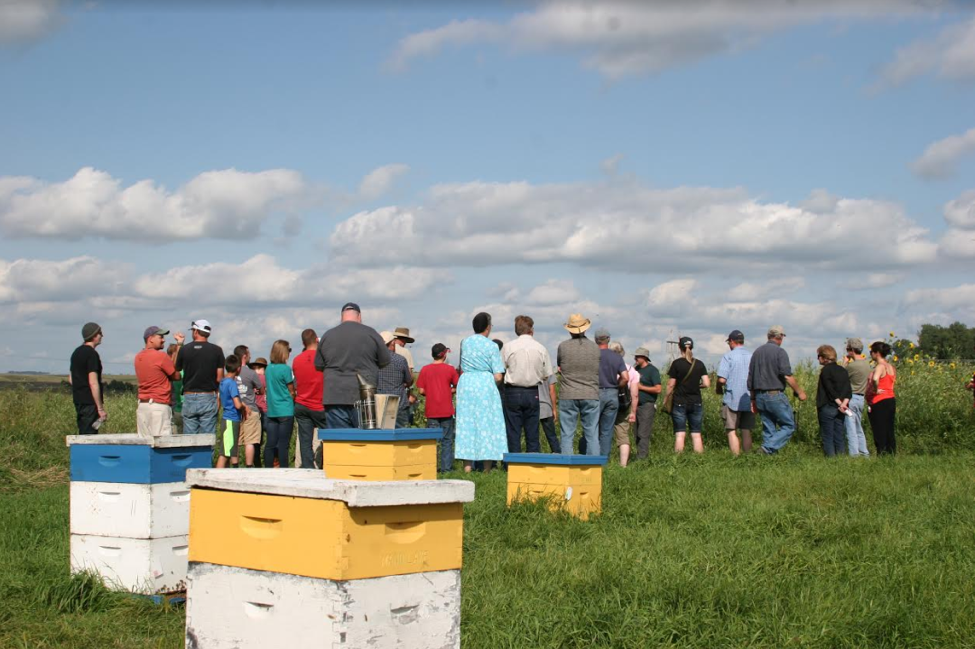The Pesticide Situation Part 5: Reinventing Nature
Contents
Biopesticides (aka “biologicals”) 1
Innovations in Mechanical Technology. 5
Agroecology and “regenerative agriculture”. 5
Resistance to change in a changing world. 7
The Pesticide Situation Part 5: Reinventing Nature
Randy Oliver
ScientificBeekeeping.com
First published in ABJ May 2019
In their never-ending battle against herbivores and parasites, plants have for eons been synthesizing toxic chemicals, collaborating with microbes, or assisting predacious insects to deter or kill pests. Now that we’ve perhaps begun getting over our synthetic pesticide hubris, and are realizing that we’re running out of new chemicals, we can learn from nature itself.
Reinventing Nature
Keep in mind that plants have successfully fought pests since long before we humans invented synthetic pesticides. We’re now starting to revisit how they do this, with the goal of developing more sustainable pest control products.
Biopesticides (aka “biologicals”)
Long favored by organic farmers, pesticides that fall into the above category tend to be pollinator- and eco-friendly, and perhaps even more importantly, are desirable to consumers — especially the Millennials who are now starting to determine market demand. Biopesticides have a lot going for them [[1]]:
- They are inherently less harmful to the environment,
- They are typically less hazardous to the applicator,
- They are designed to target only one or a few target species,
- They are often effective at low application rates, and some may self-propagate,
- They rapidly biodegrade,
- They are preferred by consumers,
- And they work well in Integrated Pest Management strategies.
Biopesticides currently account for about 5% of the pesticide market, but that proportion is expected to increase substantially. As one of the leaders in this field, Pam Marrone, explains [[2]]:
Governmental agencies are further pressuring growers by restricting or banning certain forms of conventional chemical pesticide usage… At the same time, a number of supermarket chains and food processors, key purchasers of specialty fruits, nuts and vegetables, are imposing synthetic chemical residue restrictions, limiting options available to growers close to harvest.
For example, the European Union passed legislation…that restricted and removed hundreds of pesticide active ingredients. This was followed by passage of the Sustainable Use Directive, which legislated reductions in chemical pesticides and increasing use of integrated pest management and alternatives such as biopesticides. Several countries passed programs to accelerate biologicals, for example, in Brazil and China, allowing biopesticides to get to the market more quickly and with less capital than chemicals.
Practical application: A switch to biopesticides could be very good for pollinators. And some can be best applied by bees themselves [[3]]. All projections are that biopesticides are on track to help us to manage resistant pests in a more sustainable and eco-friendly manner (Fig. 1).
Figure 1. Biopesticides are a hot topic worldwide. Although the definition varies, biopesticides can include fungi, bacteria, viruses, parasites and predators, plant extracts and oils, minerals [[4]], pheromones, hormones, RNAi or genetic engineering.
Resistant cultivars
Since plants can’t run away from predators, they fight back with chemistry. There has been a continual evolutionary chemical warfare between them and insects. Plants produce a dizzying array of chemical repellents, anti-feedants, and toxic phytochemicals in order to ward off insects. For example, some traditional maize strains in Mexico produce pollen that acts as an herbicide against competing weeds, and our favorite herbs and spices produce those aromatic molecules to deter herbivores from feeding upon them (which is why bees don’t like having essential oils dumped into their hives). But as we’ve selected strains of plants in order to make them more desirable as food for us humans, this may come at cost — if those cultivars also lose some of their protection against pests.
Practical application: The ancestors from which we’ve bred many of our favorite food crops were often poisonous or irritating to humans. Although we’ve bred out the most dangerous plant chemicals, our favorite foods still contain thousands of completely “natural and organic” phytotoxins, as elucidated by Gold [[5]].
Of all dietary pesticides that humans eat, 99.99% are natural: these are chemicals produced by plants to defend themselves against fungi, insects, and other animal predators … Each plant produces a different array of such chemicals. On average, the Western diet includes roughly 5,000 to 10,000 different natural pesticides and their break-down products. Americans eat about 1,500 mg of natural pesticides per person per day, which is about 10,000 times more than they consume of synthetic pesticide residues… Even though only a small proportion of natural pesticides has been tested for carcinogenicity, half of those tested…have been found to be carcinogenic in rodents; naturally occurring pesticides that are rodent carcinogens are ubiquitous in fruits, vegetables, herbs, and spices.
| Good news: Plants developed flowers, nectar, and nutritious pollen in order to attract pollinators, but when breeding for productivity, we sometimes inadvertently bred some of those traits out of certain cultivars. Some good news from Tennessee Department of Agriculture Apiary Inspector William R. Frazier Jr is that Pioneer is phasing out its soybean cultivar 47T36, which provides scant nectar for bees, and replacing it with P46A57BX, which is far more bee attractive. |
Before the invention of manmade insecticides, traditional farmers would select for cultivars that repelled pests on their own. Many of those resistant cultivars still exist. Unfortunately, as pointed out by Adaskaveg [[6]], it may take years to incorporate those genetics by conventional breeding into perennial tree and vine crops, plus “crop characteristics selected by the breeder to meet consumer demands often result in higher disease susceptibility of the crop.”
Today’s plant breeders are revisiting this natural pest resistance, both by reincorporating genes for pest resistance from ancestral varieties (Fig. 2), or by introducing species-specific toxins into crops, such as genetically-engineered Bt “Cry” (for “crystalline”) proteins into corn and cotton. The huge advantage of this technology is the specificity of the toxic action — in the case of the Cry proteins, they only target insects that actually take a bite out of the plant (as opposed to having to be needlessly sprayed all over the field), and can be specific for beetles and caterpillars, while remaining relatively harmless to pollinators and other beneficial insects [[7]].
Practical application: The adoption of Bt crops has greatly reduced the application of pesticides on U.S. cropland, with little apparent environmental cost. On the other hand, the widespread use of Roundup Ready® crops has reduced the erosion and fuel associated with weed control by tillage, and helped to increase carbon sequestration in the soil, but at the environmental cost of increased use of glyphosate herbicide and the reduction of beneficial insects that previously fed upon those weed species.
Figure 2. Some years ago I worked with an Israeli startup seeking to use RNAi to make tomato and potato plants resistant to a devastating disease carried by the psyllid insects above (in a leaf-inoculation cage of my own design). In my lab I found that some tomato cultivars were already resistant to the disease. Nowadays, breeders could use precision CRISPR gene editing to transfer those genes for resistance to currently-susceptible cultivars, thus eliminating the need for weekly spraying of neonicotinoids to control the psyllid.
Practical application: There is huge potential in “precision breeding” of plants via genetic engineering — by either reintroducing natural genes for pest resistance, or by creating novel ways for crops to defend themselves in an environmentally-friendly manner. The sooner we drop the unfounded negative stigma of “GMO,” the more quickly plant breeders can develop cultivars that are innately resistant to pests.
Intensive Agriculture
One commonly-proposed answer to The Pesticide Situation is to shift to “organic” agricultural practices. What’s not to love about “organic” farming? But what we need to do is to differentiate between the term “organic” as used as a marketing term — riding on the common misconception that it implies being free of pesticides, as compared to the concept of agro-ecological farming — focused upon maximum sustainability and minimal environmental impact. Although there is considerable overlap between the two, the arbitrary restrictions for “organic” certification don’t allow some options that may be better for biodiversity and the environment in the Big Picture. Until we get the growth and demands of our growing human population under control, agriculture’s most promising course of action appears to be to embrace a combination of high-tech, high-intensity farming, in order to spare the conversion of our threatened wildlands to cropland.
Practical application: I’ve been a booster for organic farming for decades. But in recent years I feel that “organic” has lost its way, and is now more caught up in being “anti” this or that, rather than being “pro” feeding the human population with the least environmental impact.
Innovations in Mechanical Technology
One of the biggest challenges in agriculture is the amount of labor involved. Humans soon learned how to harness animals to drag the plow, and nowadays a single diesel-fueled tractor can have the power of hundreds of horses (thus making larger farms more efficient). California agriculture is suffering from a shortage of legal residents who want to work on farms, and as a result is in a race to convert to next-generation automation and robotics. This will likely be good news for beekeepers, since robotic pesticide applications can be more precise, and applied at night. Another exciting development is robotic weeders, which could greatly reduce or even eliminate the need for herbicide applications [watch a video[8] ]. This could really help pollinators, since as farmers are forced to switch from glyphosate (Roundup®) to dicamba herbicide (due to resistance issues), the drift of this chemical eliminates the flowering weeds around field margins.
Practical application: Robotic insect and weed control could make cropland and field margins more pollinator-friendly by reducing both insecticide and herbicide application and drift.
I’d now like to introduce two new buzzwords in agriculture:
Agroecology and “regenerative agriculture”
Farming practices are often divided into two extremes — conventional and “organic” — a marketing term allowed by the USDA. Growers may receive a premium for products that meet the standards for “certified organic,” but that premium is beginning to fade. In reality, there is a large gray area between the two extremes, with many farmers being very much concerned about sustainability and being environmentally responsible, but not willing to pursue the arbitrary restrictions of organic certification. The question then is, can such environmentally-conscious farmers still be financially rewarded even if they don’t meet the organic certification standards? According to a recent study by LaCanne and Lundgren, it appears to be so (Fig. 3):
Figure 3. This chart, from the LaCanne and Lundgren study [[9]] determined the overall profitability of growing corn in the Northern Plains under two different types of farming practices. Not shown here is that insect pest populations were more than 10-fold higher on the insecticide-treated farms than on the insecticide-free regenerative farms.
“Despite having lower grain yields, the regenerative system was nearly twice as profitable as the conventional corn farms. [That] relative profitability…was driven by the high seed and fertilizer costs that conventional farms incurred …, and the higher revenue generated from grain and other products produced (e.g., meat production) on the regenerative corn fields.”
It’s not that farmers can’t continue to supply our food needs, but that they can do it in a more environmentally-friendly manner. Australian conservation scientist Dr. Andrew Balmford has authored several papers on integrating eco-friendly practices into high-intensity commercial agriculture [[10]].
All that information does us little good unless it gets to the farmers themselves. Our agricultural extension services are realizing that they haven’t been keeping up with the times. A recent article in California Agriculture [[11]] points out that ag extension agents need to start adopting a “from the ground up” approach for informing growers through the use of social media and demonstration projects.
Practical application: It’s easy to complain, but more meaningful to offer solutions. If family farmers don’t break even, they may go out of business, and their land may be bought up by larger farms (due to such consolidation, the median acreage of farms today is over 1200 acres). Contrary to the example of the E.U. imposing politically-motivated restrictions top-down, it may be better to offer bottom-up demonstration projects to show how to practice profitable farming with minimal pesticide use.
To that end, Dr. Jon Lundgren (coauthor of the study above) quit the USDA in order to establish Blue Dasher Farm ― a Research and Demonstration Farm in Regenerative Agriculture, in South Dakota (Fig. 4). Jon works closely with a large commercial beekeeper, and one of his missions is to demonstrate how to practice bee-friendly farming. He is also involved in projects in California and other states. I applaud Jon for his efforts to demonstrate in real life how farmers can improve their practices — he deserves our strong support.
Figure 4. A demonstration day at Blue Dasher Farm. Similar to beekeepers, growers tend to copy the practices of other successful farmers. Demonstration farms are perhaps the best way to show them how to improve their practices.
Action item: Put your money where your mouth is. You can financially support Dr. Lundgren’s demonstration projects at https://www.ecdysis.bio/take-action/ Jon is walking the walk, and if he can show other Midwestern growers how they can profitably improve their practices to the benefit of bees and the environment, others will copy him. Disclosure: I’ve donated substantially to Blue Dasher Farm.
Resistance to change in a changing world
I feel for our farmers — they are being forced to rapidly adapt to a changing world. And many of those adaptations are not of their own choosing. There is a fundamental human objection to having the will of others imposed upon us. Farmers and landowners can be expected to resist change, unless they feel that the benefits and rewards for making the change are seen as adequate for the trouble involved. Luckily for us, one of those benefits is landowners’ common desire to be good stewards of their land for future generations (as well as not inadvertently poisoning their families). We commercial beekeepers are part of the agricultural community, and will do best if we learn to present our suggestions in a productive and positive manner.
Practical application: We beekeepers will have far greater success in getting landowners and growers to work with us if we better understand the reasons why any of us fight having to change how we do things. Our industry would do well to familiarize ourselves with what best works to overcome others’ kneejerk resistance to change. I’ve found Torben Rick’s Top 12 Reasons Why People Resist Change to be enlightening and helpful — take a look for yourself [[12]].
To be continued…
Notes and citations
[1] Gupta, S & AK Dikshit (2010) Biopesticides: An eco-friendly approach for pest control. Journal of Biopesticides 3: 186-188.
[2] Marrone, PG (2014) The market and potential for biopesticides. Chapter 16, pp 245–258, in Biopesticides: State of the Art and Future Opportunities, ACS Symposium Series, Vol. 1172. DOI: 10.1021/bk-2014-1172.ch016
[3] (Broken Link!) https://ec.europa.eu/agriculture/sites/agriculture/files/expo-milano-2015/cap-events/organic-farming/hokkanen_en.pdf
https://entomologytoday.org/2014/09/25/entomovectoring-uses-bees-to-fight-fungus-with-fungus/
[4] According to the EPA, Biopesticides are certain types of pesticides derived from such natural materials as animals, plants, bacteria, and certain minerals. For example, canola oil and baking soda have pesticidal applications and are considered biopesticides. Kaolin clay is also commonly used. https://www.epa.gov/ingredients-used-pesticide-products/what-are-biopesticides
[5] Gold, LS, et al (2002) Misconceptions about the causes of cancer. https://toxnet.nlm.nih.gov/cpdb/pdfs/Gold_Misconceptions.pdf
[6] Adaskaveg, J, et al (2012) Fungicides, bactericides, and biologicals for deciduous tree fruit, nut, strawberry, and vine crops 2012. http://cestanislaus.ucanr.edu/files/143369.pdf
[7] Xie, X, et al (2019) Bacillus thuringiensis maize expressing a fusion gene Cry1Ab/Cry1AcZM does not harm valued pollen feeders. Toxins 11(1): 8.
[8] (Broken Link!) https://youtu.be/Lw4p31gtX60
[9] LaCanne CE& JG Lundgren (2018) Regenerative agriculture: merging farming and natural resource conservation profitably. PeerJ 6:e4428 https://doi.org/10.7717/peerj.4428
[10] Balmford, A, et al (2018) The environmental costs and benefits of high-yield farming. Nature Sustainability 1: 477–485. This paper is open access, with a number of useful citations.
[11] Lubell, M & N McRoberts (2018) Closing the extension gap: Information and communication technology in sustainable agriculture. Calif. Agri 72(4): 236-242.
[12] https://www.torbenrick.eu/blog/change-management/12-reasons-why-people-resist-change/







